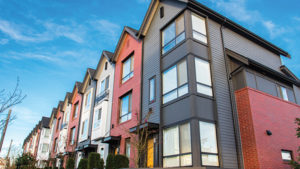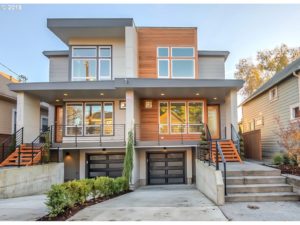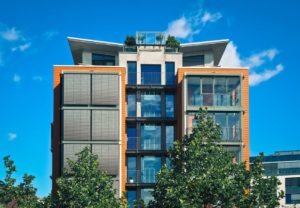Are you planning on investing in real estate? If so, you may be debating investing in residential vs. commercial real estate and are wondering if there’s a difference. The answer to this question is yes.
In this article, we will break down commercial real estate investing and provide you with all of the information that you need before you make your first commercial real estate investment.
What Is Commercial Real Estate?
Commercial real estate is a property that’s been leased out for retail and business purposes. When it comes to multifamily properties, any property that has more than one unit will typically qualify as a commercial property.
There are a wide variety of multifamily properties available around the world today. You can invest in apartment complexes, condominiums and or town homes.
Many investors get started with investing in multifamily properties by purchasing a small multifamily property (2-4 units) so that they can live in one of the units while renting out the other units to tenants.
Also known as “house hacking”, this is also an excellent way for an investor of any age to get their start in multifamily while also helping to lower their housing costs at the same time.
Tips for Buying A Multifamily Property
Although most investors dream about buying multifamily properties because they know that the more doors that they have in their portfolio, the more income they are going to earn. The reality is that buying a multifamily property isn’t always that easy.
Thankfully, we’ve provided you with several steps that you should follow which will help you to buy your first property:
#1 – Research the Area
The property may be a newer multifamily property in a great area but the big question is that area a place where renters want to live?
To research the area where a multifamily rental property is located, simply analyze the following data:
- Review job trends for the area – Are local companies hiring or firing?
- Is the population growing or are people moving out?
- What is the demographic “makeup” of the area?
- Do you feel safe in the area? Does it have a low, high or average crime rate?
- How is the cost of living in the area when compared to other cities nationwide?
#2 – Evaluate the Investment Property
Is the multifamily property in good condition or will it need improvements before you start renting it out?
If the property is going to need to be repaired before you start renting it out, it’s best to make those repairs ASAP, just make sure that you estimate repairs on the high side so that you have plenty of money in your budget to get them done.
#3 – Know Your Cap Rate
Another important thing to do when reviewing a multifamily property is to know your cap rate before you purchase a property. To figure out your cap rate, all you need to do is take your net operating income (minus expenses) and divide that number by your purchase price.
#4 – What Is the Unit Mix?
The unit mix is the percentage of units in the property that are two-bedroom, one-bedroom and three-bedrooms. Find out what types of units the property currently has because it may be more difficult to rent a three-bedroom unit in the market where that property is located compared to a one-bedroom unit.
#5 – Find Out Why the Current Owner Is Selling
Even if the property looks great on paper, you absolutely must find out why the owner is selling because, first and foremost, you want to have a motivated seller and secondly, you don’t want to buy a problem property from someone else.
Multifamily Investing Benefits
A multifamily property, sometimes referred to as a multiwall unit (MDU), is a type of residential housing with two or more units under one roof or several buildings within one complex. They are generally comprised of many configurations, with the most common examples being duplexes, townhouses, and some types of condos. Each unit tends to have its own living space, a separate kitchen, and bathroom. Although the definition differs from situation to situation, a multifamily property will generally consist of owning a combination of the property and the land on one recorded deed. In some cases, it can be owned by one or more parties.
While they are the least common type of residential buildings, investing in multifamily properties is an immensely favorable strategy among investors thanks to their additional source of monthly income, along with slow but steady appreciation. As an investor, the advantages of owning a multifamily property include:
- Bigger Cash Flow: If a single-family property generates a single monthly income, why not invest in a multifamily property producing multiple forms of monthly income? While the allure of investing in multifamily properties is easy to see, these investments represent an innovative opportunity to generate additional income from one investment. In addition, investors may decide to live in one unit and rent out the others for income. When it comes to passive income retirement investing, a multifamily property can be used in multiple ways.
- More Control Over Value: The more income a property receives, the higher the value is. Because multifamily properties are comprised of more units, which means earning multiple streams of income, these types of investments are generally valued higher than single-family homes, which are dependent on comparable sales as rentals.
- Larger Pool of Tenants: One of the underlying benefits of investing in multifamily properties is less risk. How do you ask? Because, unlike single-family units, where income is lost when the home is vacant, multifamily properties have numerous units and alleviate the total economic loss for investors.
- Scalability: Multifamily investments epitomize scalability. Rather than purchasing individual properties and slowly growing your business one transaction at a time, these investments represent the opportunity to acquire multiple properties within one building. They are perfect for those looking to grow their real estate investment portfolio and take their business to the next level, with the option for investors to venture into the arena of mixed-use and apartment investing down the road.
In its simplest form, beginner investors should conceptualize a multifamily property as a hybrid between a single-family home and a condo where both the structure and the land are owned and on file in one recorded deed. Along with the ability to generate more income than a single-family property, these investments are ideal for those looking to not only grow their business but offset risks when generating monthly income.
Multifamily Investing Outlook For 2020
Will there continue to be a demand for multifamily properties in 2020? The answer to this question is yes. From big cities like Portland Oregon, to smaller cities nationwide, multifamily properties will continue to be in demand because there are more people than ever before who are choosing to rent properties instead of buying.
Lessons Learned
As Real Estate investor, Joe Fairless, once said, “An immutable law of investing is to invest for cash flow, not appreciation.” With this law in mind, always make sure that you do the numbers when investing in multifamily and make sure that it’s a property that will produce enough cash flow to cover your monthly expenses because you don’t want to end up “upside-down” on the property, losing money each month.
Contact Rent Portland Homes
To learn more about the property management services that Rent Portland Homes can offer you contact us today by CLICKING HERE to connect with us online through our website.








